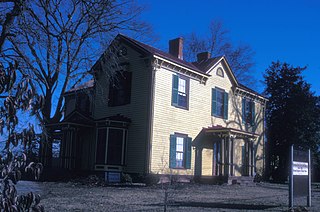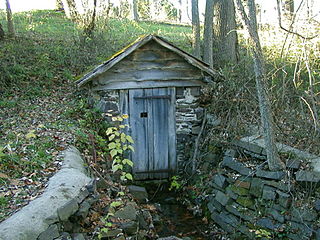
Stagville Plantation is located in Durham County, North Carolina. With buildings constructed from the late 18th century to the mid-19th century, Stagville was part of one of the largest plantation complexes in the American South. The entire complex was owned by the Bennehan, Mantack and Cameron families; it comprised roughly 30,000 acres (120 km2) and was home to almost 900 enslaved African-Americans in 1860.

The Willis M. Graves House, also known as the Graves-Fields House and Oakcrest, is a historic home located on Oberlin Road in Raleigh, Wake County, North Carolina. It was built about 1884 in the freedmen's village of Oberlin, and is a two-story, frame Queen Anne style dwelling. It has a projecting, two-story polygonal bay capped by a very large gable; one-story wraparound porch; and a projecting, two-story square tower with a pyramidal roof. It was built by Willis M. Graves, an African-American brick mason.

The Hood–Anderson Farm is a historic home and farm and national historic district located at Eagle Rock, Wake County, North Carolina, a suburb of the state capital Raleigh. The main house was built about 1839, and is an example of transitional Federal / Greek Revival style I-house. It is two stories with a low-pitched hip roof and a rear two-story, hipped-roof ell. The front facade features a large, one-story porch, built in 1917, supported by Tuscan order columns. Also on the property are the contributing combined general store and post office (1854), a one-room dwelling, a two-room tenant/slave house, a barn (1912), a smokehouse, and several other outbuildings and sites including a family cemetery.

The Guitar House, previously known as Confederate Hill, is a historic home located in Columbia, Missouri. It was built between 1859 and 1862, and is a two-story, Italianate style dwelling. It has a low pitched hipped roof, tall slender windows with segmented arches, decorative eave brackets, and a single story front porch with square supports. The house was constructed by David Guitar, an officer in the Union forces during the American Civil War. The house was added to the National Register of Historic Places in 1993.

The Carson House is a historic house and museum located in Marion, North Carolina that was the home of Col. John Carson, and served as the McDowell County courthouse at the county's inception.

Hotel Charlotte was a 13-story hotel in Charlotte, Mecklenburg County, North Carolina, which opened in 1929. It was on the corner of Trade Street and Poplar Street in the Uptown area of Charlotte.

The Dred and Ellen Yelverton House is a historic home located near Fremont, Wayne County, North Carolina. It was designed by architect George Franklin Barber, is one of the most intact Barber houses in North Carolina. It was built about 1913, and is a two-story, weatherboarded frame dwelling with elements of Queen Anne and Colonial Revival style architecture. It has a steep deck-on-hip slate roof, one-story rear ell, and one- and two-story wraparound verandah. Also on the property is a contributing Carbide House.

Buck's Upper Mill Farm, also known as Henry Buck House, is a historic home located at Bucksville in Horry County, South Carolina. The house was built about 1838 and is a typical two-story, central hall, framed farmhouse, or "I"-House. The front façade features a full-length, one-story porch with a shed roof supported by six square posts. Also on the property are a one-story frame building constructed in the 19th century as a commissary for Buck's lumber business, and the ruins of a sawmill.

John Bunyan Green Farm is a historic home and farm and national historic district located near Midland, Cabarrus County, North Carolina. The district encompasses 12 contributing buildings, 2 contributing sites, and 1 contributing structure. The farmhouse was built about 1880, and is a two-story, frame dwelling with Italianate style design elements. It features a two-story gabled front porch, a gable roof, and two exterior end chimneys. Also on the property are the contributing ten outbuildings, well canopy, the Garmon Mill site, the miller's house, and the fields and woods.

Jerkins-Duffy House, also known as the Clarence B. Beasley House, is a historic home located at New Bern, Craven County, North Carolina. It was built about 1833, and is a 2 1/2-story, three bay, side-hall plan, transitional Federal / Greek Revival style frame dwelling. It has an engaged, full-width two-story rear gallery and one-story wings. It sits on a high brick foundation.

Buckner Hill House is a historic plantation house located near Faison, Duplin County, North Carolina. It was built about 1860, and is a two-story, five bay by five bay, square Italianate style frame dwelling with a cruciform plan. The house rests on high brick piers and is capped by a low deck-on-hip roof. It features lavish wooden and plaster ornamentation and center bay porches on each elevation. Also on the property are the contributing kitchen, smokehouse, and storehouse.

Worsley-Burnette House is a historic plantation house located near Conetoe, Edgecombe County, North Carolina. The original section was built about 1830, as a two-story, hall-and-parlor plan, Federal style frame dwelling. It was expanded about 1850 with a Greek Revival style end wing.

David Jenkins House was a historic home located at Gastonia, Gaston County, North Carolina. It was built about 1876-1877, and was a two-story, three bay, frame farmhouse with Greek Revival and Italianate style design elements. It featured a low hip roof supported by ornamental brackets. It was built by David A. Jenkins (1822–1886), a Republican politician and North Carolina State Treasurer from 1868 until 1876. The house has been demolished.

Speight-Bynum House is a historic plantation house located near Walstonsburg, Greene County, North Carolina. It was built about 1850, and is a two-story, double pile, three bay, Greek Revival style heavy timber frame dwelling. It has a one-story rear addition built in 1938, a low hip roof, and one-story full width front porch. Also on the property is a contributing smokehouse.

Harper House, also known as the Ragan House, is a historic farmhouse located in Trinity Township, near Archdale, Randolph County, North Carolina. It was built about 1815, and is a two-story, three bay by two bay, Federal period frame dwelling, with a lower two-story, three bay by two bay wing. It has a hipped roof, rests on a brick foundation, and has flanking exterior end chimneys.

Gov. David S. Reid House is a historic plantation house located at Reidsville, Rockingham County, North Carolina. It was built about 1881, and is a two-story, "T"-shaped, Late Victorian style frame dwelling. It sits on a brick foundation and has a gable roof and original one-story, rear shed projection and one-story rear kitchen wing. The front facade features a hipped roof entrance porch. It was the home of the home of North Carolina Governor David Settle Reid (1813-1891) from 188l until his death in 1891.
Fewell-Reynolds House is a historic home located near Madison, Rockingham County, North Carolina. It was built about 1820, and is a two-story, six bay, central hall plan, Federal style frame dwelling with a one-story wing. It sits on a stone and brick foundation and has a steeply pitched gable roof. The front facade features a four bay shed roofed porch.

Ivey-Ellington House is a historic home located at Cary, Wake County, North Carolina. The house was built about 1870, and is a 1 1/2-story, "T"-plan, frame I-house with board-and-batten siding. It has a steeply pitched roof, decorative scalloped gable trim, and pointed-arch windows.

Buck Spring Plantation, also known as the Nathaniel Macon House, is a historic plantation house site located near Vaughan, Warren County, North Carolina. The property includes the graves of politician Nathaniel Macon (1757-1837) and his wife Hannah Plummer Mason, log corn crib, smokehouse, caretaker's house, and reconstructed dwelling house dated to the 1930s.

The Will H. Buck House is a historic building in Vacaville, California, United States. Designed by George Sharpe, it was built in 1892 in the Queen Anne style and was placed on the U.S. National Register of Historic Places on October 24, 1985.

















